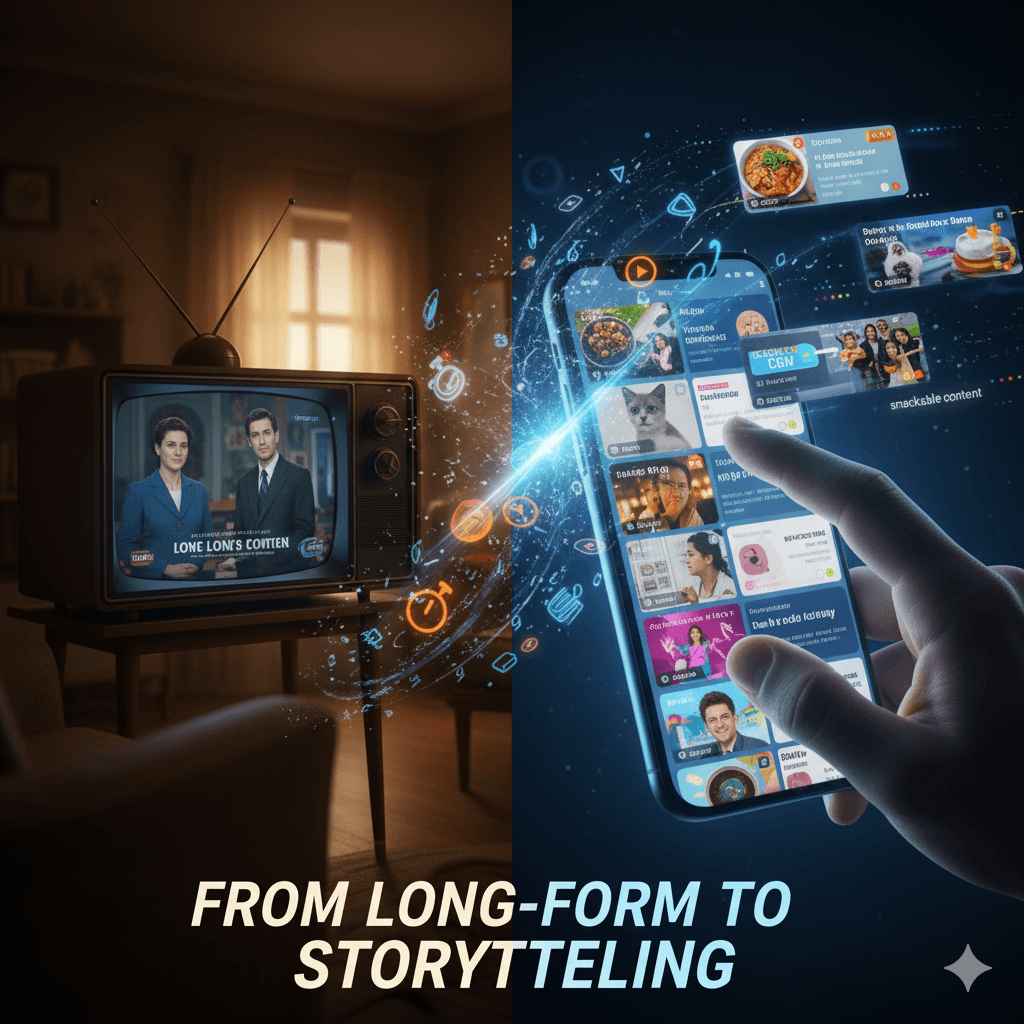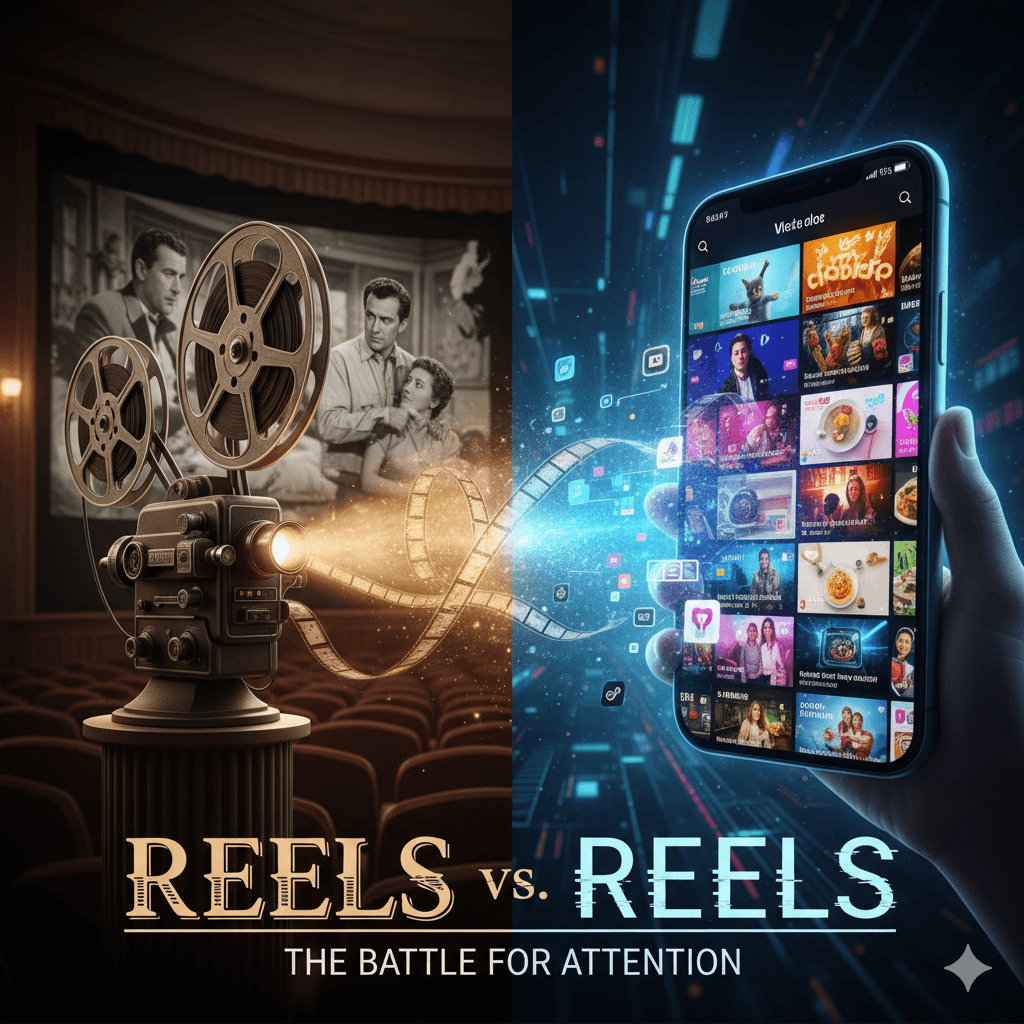The Future of Cinema in the Age of Short-Form Video
As short-form videos dominate digital screens, the traditional cinema experience faces its biggest transformation yet. This article explores how TikTok, YouTube Shorts, and streaming platforms are reshaping storytelling, audience habits, and the very definition of film in an era driven by speed, creativity, and constant engagement.

Introduction: A Clash Between Reels and Reels
Once upon a time, the word “reel” meant a roll of film — a long strip of cinematic magic running through a projector. Today, it means something entirely different: a 15-second video loop on your phone.
In less than a decade, storytelling has been compressed — from 3-hour epics in theatres to 30-second bursts on TikTok or Instagram. We now live in an era where people say, “If it doesn’t grab me in 5 seconds, I’m scrolling.”
So where does that leave cinema — the grand, immersive art form that demands time, patience, and attention? Will it fade away, or reinvent itself in this age of short-form video?
This is the story of how cinema is fighting to stay alive in a world addicted to speed.
1. The Rise of Short-Form Storytelling
There was a time when “content” meant TV shows, news, or films. Now, the word includes everything from a 7-second meme to a 60-second micro-documentary.
⚡ From Long-form to “Snackable”
TikTok, YouTube Shorts, and Instagram Reels have revolutionized how we consume entertainment.
- TikTok crossed 1 billion active users in under five years.
- YouTube Shorts records over 70 billion views daily.
That’s not just content consumption — that’s a global habit.
Short-form content is addictive because it fits perfectly into modern life. Whether you’re on a bus, between meetings, or procrastinating before bed — there’s always time for one more video.
🎬 Micro Storytelling is the New Craft
Creators are now telling complete stories in less than a minute. They use jump cuts, trending sounds, and fast pacing to evoke laughter, emotion, or suspense — all before your thumb swipes again.
Platforms are filled with “micro-films” that showcase entire character arcs in under 60 seconds. Think of it as the Twitter version of cinema — compressed but clever.
Graf suggestion:
📊 Bar chart comparing average watch time:
- Traditional movie: 120 mins
- YouTube video: 8 mins
- Short-form video: 20–60 seconds
This visual emphasizes how drastically attention duration has shrunk over time.
2. The Shrinking Attention Span: The Attention Economy Crisis
We live in the “attention economy,” where your time is the currency and platforms compete for every second of it.
According to Microsoft’s 2023 study, the average human attention span is now 8.25 seconds, shorter than a goldfish’s.
📱 The Power of the Scroll
Every swipe, like, and view teaches algorithms what you want. These systems are designed to hook you — not with depth, but with dopamine. That’s why short-form videos are engineered for instant satisfaction: fast edits, punchy hooks, cliffhangers, and emotional payoffs.
But here’s the twist — this conditioning doesn’t just change what we watch. It changes how we watch everything.
When audiences sit down for a two-hour film now, many feel restless. They check their phones mid-scene. They skip slow intros. They want constant stimulation — something traditional cinema was never built for.
Graf suggestion:
📈 Line graph showing decline in average uninterrupted watch time (2010–2025)
3. Cinema’s Identity Crisis: Can Art Survive Speed?
Cinema has always been more than entertainment. It’s art. It’s storytelling that takes time to breathe, build tension, and explore emotion. But the world’s rhythm has changed.
Today, everything is faster — even our emotions. Love, anger, humor — all packaged into short, looping clips.
🎞️ The Slow Art in a Fast World
Movies like Oppenheimer and Dune ask for deep attention and patience. Yet, they coexist with viral short clips of cats, lip-syncs, and food reviews.
The contrast is jarring. But it also forces cinema to ask a painful question: Does anyone have time for stories that unfold slowly anymore?
While some claim “cinema is dying,” others argue it’s simply evolving to survive — just as it did when television and streaming came along.
4. Evolution, Not Extinction: Cinema’s Smart Adaptation
Cinema isn’t dead — it’s transforming.
🍿 From Theatres to Streams
First came the fall of theatres during the pandemic. Then came the rise of OTT platforms — Netflix, Prime Video, Disney+. Viewers learned they could enjoy cinematic experiences from home.
Now, filmmakers promote their work using short-form clips, teasers, and behind-the-scenes snippets to hook audiences. A 30-second TikTok might convince someone to watch a 3-hour film.
Even Netflix has adapted by launching “Fast Laughs”, a TikTok-style feature that showcases short comedy clips from its catalog — blending short-form energy with long-form content.
Graf suggestion:
🎬 Infographic showing the shift:
Cinema → TV → Streaming → Short-form → Hybrid
🎥 Filmmakers Go Vertical
Some directors now shoot scenes designed for mobile viewing — vertical formats, shorter acts, and tighter pacing.
- Independent filmmakers use Reels to crowd-fund projects.
- Film festivals (like TikTok Short Film Festival) now celebrate 1-minute films as legitimate art.
Cinema is learning to speak the language of the internet — short, emotional, shareable.
5. The Creative Revolution: When Anyone Can Be a Filmmaker
The biggest change short-form video brought? Democratization.
A smartphone is now a movie studio in your pocket. Anyone can write, shoot, edit, and publish — all within minutes.
🌍 Storytelling Without Permission
You no longer need a studio’s approval or a million-dollar budget. You just need an idea — and a camera.
Many viral creators have turned their short videos into careers, landing Netflix deals or brand sponsorships.
For instance:
- Filmmaker Nuseir Yassin (Nas Daily) started with 1-minute videos on Facebook. Now he runs a global storytelling company.
- TikTokers like Khaby Lame built massive followings without uttering a single word — proving that storytelling transcends language.
Graf suggestion:
📊 Pie chart of content creators by platform (YouTube, TikTok, Instagram, etc.) showing growth from 2018–2025.
This visual would highlight how filmmaking power has shifted from studios to individuals.

6. The Science Behind Why We Love Short Videos
🧠 Dopamine on Demand
Short videos provide quick emotional payoffs. Each swipe releases dopamine, training our brains to crave more. It’s not about story depth; it’s about instant feeling.
⏱️ The Loop of Addiction
Platforms design infinite scrolls — there’s no “end.” This psychological trick keeps viewers in a loop, consuming endlessly.
Yet, the more people consume, the less patience they have for slower narratives. It’s not just changing viewing habits — it’s rewiring our brains.
7. The Middle Ground: Can Both Worlds Coexist?
Cinema and short-form content don’t have to be enemies. In fact, they complement each other beautifully when balanced right.
🎭 Short-Form as the Trailer to Cinema
Short-form can serve as an appetizer — a gateway drug to long-form storytelling.
A 30-second emotional short might push viewers toward a full film exploring the same theme.
🧩 Hybrid Storytelling
Some filmmakers are experimenting with “multi-format narratives.”
- Release a series of short clips online to introduce characters.
- Follow up with a feature film or OTT series for the full story.
This mix keeps audiences hooked while satisfying the craving for depth.
Real example:
Marvel’s social media strategy uses short clips, memes, and behind-the-scenes content to keep fans engaged between films — turning cinema into an always-on conversation.
Graf suggestion:
🔄 Flow diagram:
Short-form video → Engagement → Interest → Full-length viewing → Fandom
8. The Future of Cinema: Adapting, Not Abandoning
The future of cinema won’t be about resisting change. It’ll be about redefining the cinematic experience.
💡 Possible Directions Ahead
1. Interactive Cinema
Think of Netflix’s Black Mirror: Bandersnatch, where viewers choose the story’s path.
Future films may include audience interaction, AR layers, or personalized plots.
2. AI-Enhanced Filmmaking
AI tools like Runway and Sora already generate visual scenes. Soon, filmmakers might blend real and synthetic visuals for richer storytelling.
3. Immersive Cinemas
With VR and 360° experiences, cinema may become an interactive environment — not just a passive screen experience.
4. Cross-Platform Storytelling
Studios may create worlds that live across formats: a short TikTok prequel, a web series spin-off, and a feature film finale — all interconnected.
Graf suggestion:
🚀 Futuristic timeline infographic:
2020 – Rise of OTT
2023 – Short-form explosion
2025 – Hybrid storytelling
2030 – Fully immersive cinema
9. Challenges That Cinema Still Faces
Even with evolution, challenges remain:
- Monetization: Short-form content is more challenging to monetize. Cinema still offers structured revenue (tickets, OTT deals).
- Artistic Value: Critics argue that short videos dilute artistic storytelling.
- Oversaturation: Excessive content can lead to audience fatigue.
- Quality vs Quantity: Algorithms reward frequency, not depth — which can stifle creativity.
Graf suggestion:
⚖️ Pros & Cons chart comparing “Cinema vs Short-Form Video” (depth, reach, artistry, monetization, etc.)
10. Why Cinema Will Never Truly Die
Cinema isn’t just a medium — it’s a collective ritual.
It’s sitting in a dark hall, surrounded by strangers, feeling something bigger than yourself. It’s the gasp, the silence, the shared emotion.
No TikTok or Reel can replicate that.
Even as the world embraces shorter formats, cinema remains the emotional core of storytelling. Because what truly matters isn’t the length of a story — it’s the impact it leaves behind.
As long as humans crave meaning, depth, and beauty, cinema will evolve — not vanish.
Conclusion: The Story Will Always Find a Way
We may watch stories on different screens now — from IMAX theatres to tiny smartphone displays — but the essence of storytelling hasn’t changed.
Cinema will learn to coexist with short-form video, using it as a bridge, not a threat. The filmmakers of tomorrow will be just as comfortable making 30-second masterpieces as 3-hour epics.
The future of cinema isn’t shorter — it’s smarter, faster, and more connected than ever.
Because no matter how technology evolves, one truth remains:
Stories will always survive.
